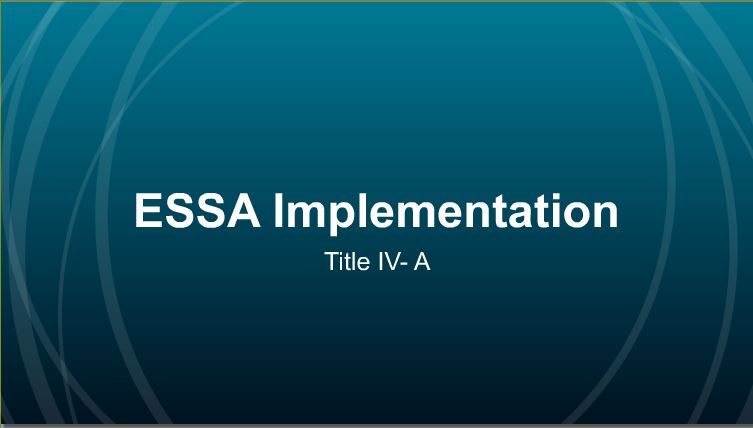Allowable Activities
Title IVA funds may be used to provide supplemental services and/or supports that address one or more of the priorities of this grant. Funds may be used for, but not limited to the following: direct services, professional development, salaries, and materials/supplies. Districts should coordinate the use of Title IVA funds with other federal, state, and local funds while ensuring that all Title IVA funds are only used to support activities that are in addition to those that the district would otherwise support through the state or local sources. The resource Non-Regulatory Guidance: Using Evidence to Strengthen Education Investments provides guidance on program selection.
There are three areas supported under Title IV, Part A, including
- Well-Rounded Educational Opportunities (4107),
- Safe and Healthy Students (4108), and
- Effective Use of Technology (4109).
Additional Resources
New: School Mental Health Funding: Expenses 101 Quick Guide
Title IV-A allowable costs Q&A
Title IV-A: Fiscal Questions for consideration
Evidence-Based Improvement Strategies presentation
Online Databases for Investigating Evidence-Based Improvement Strategies
Well-Rounded Educational Opportunities (ESEA section 4107)
- Improving access to foreign language instruction, arts, and music education
- Supporting college and career counseling, including providing information on opportunities for financial aid through the early FAFSA
- Providing programming to improve instruction and student engagement in science, technology, engineering, and mathematics (STEM), including computer science, and increasing access to these subjects for underrepresented groups
- Promoting access to accelerated learning opportunities including Advanced Placement (AP) and International Baccalaureate (IB) programs, dual or concurrent enrollment programs and early college high schools
- Strengthening instruction in American history, civics, economics, geography, government education, and environmental education
Safe and Healthy Students (ESEA section 4108)
- Trauma-sensitive schools
- SBIRT
- Youth Mental Health First Aid
- Academic and Career Planning
- AODA and tobacco prevention
- Restorative Practices
- School safety and preparedness
- Promoting community and parent involvement in schools
- Providing school-based mental health services and counseling
- Promoting supportive school climates to reduce the use of exclusionary discipline and promoting supportive school discipline
- Establishing or improving dropout prevention
- Supporting re-entry programs and transition services for justice-involved youth
- Implementing programs that support a healthy, active lifestyle (nutritional and physical education)
- Implementing policies and practices to prevent bullying and harassment
- Developing relationship building skills to help improve safety through the recognition and prevention of coercion, violence, or abuse
- Establishing community partnerships
Effective Use of Technology (ESEA section 4109)
- Supporting high-quality professional development for educators, school leaders, and administrators to personalize learning and improve academic achievement
- Carrying out innovative blended learning projects
- Providing students in rural, remote, and underserved areas with the resources to benefit from high-quality digital learning opportunities
- Delivering specialized or rigorous academic courses, professional learning, and curricula using technology, including digital learning technologies and assistive technology
Provided a well-rounded education integration with the effective use of technology spending:
- Instructional programming and professional learning
- New Information and Technology Standards (ITL) representing opportunities across many areas of ESSA
- Integrated digital learning connections: digital literacy, instructional supports, innovative areas of instruction (STEM, computer science, personalized learning, blended and online learning, and much more relative to programming)
- Rural equity programming related to offering enhanced learning opportunities
- College and Career connection programming, career pathways that have instructional integration connections including STEM, computational programming, and Computer Science
- Professional learning for educators around integrated topics related to the integration of instructional technology, UDL, digital citizenship and online wellness related to classroom and student-level instructional connections)
- Use evidence-based innovations with instructional technology
- Data based interventions and resources related to driving student instructional outcomes (relative to personalized/student-centered learning)
- Close your achievement gaps
- Key principles of the WI Digital Learning Plan and DPI’s equity agenda related to defining equitable access to learning opportunities. Four key principles related to an instruction being equitable, personalized, applied, and engaged
- Equitable access including digital high-quality instructional materials (open education resources is mentioned in ESSA), highly trained professionals, and technology
- Use of digital learning options and resources for interventions as needed
- Personalized learning related to equitable learning, blended options, and data-driven instruction options for students
- ELL connections relative to closing gaps
Integrated funding for digital learning experiences
The International Society for Technology Education (ISTE) created this document, Using ESSA to fund EdTech, as a roadmap to explore options to leverage funding for integrated and innovative projects. The Department of Education, Office of Educational Technology, released a Dear Colleague Letter on January 18, 2017 that explains further the opportunities for integrated budgeting across all of the title programs for data, digital learning, infrastructure (guidance defines as software or instructional technology tools not items like broadband), digital citizenship and literacy, computing devices, digital resources, and professional learning.
Infrastructure expenses do not include broadband, central office hardware, and servers, building hardware.
District-wide software tools that do not relate directly to student-level instructional use will be coded as technology infrastructure. Keep in mind, this title should support classroom instruction and professional learning.
